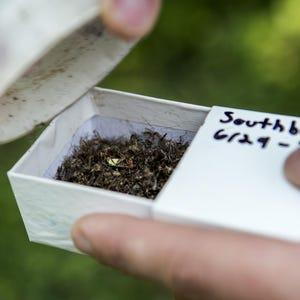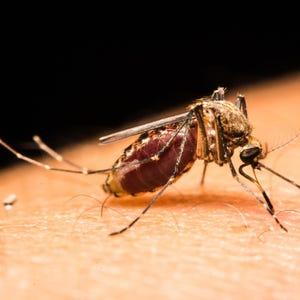- posted: Jul. 25, 2015
Summer beach days at Woodland Beach near Smyrna were always a treat for Lesley Combs.
As long as she sprayed liberally with bug spray.
The beach is known fondly as the “green head capital of the world,” meaning that there is no shortage of blood sucking greenhead horse flies. Combs recalls her family’s car literally coated with the bugs some days.
“If they were on top of the car, I didn’t get out,” she said last Thursday while sea glass and shell hunting on the beach with her daughters Jaelynn, 15, and Jayla, 9.
Luckily, this day the weather was balmy and the flies were kept at bay.
But summer beach trips and even dining al fresco in Delaware can be hijacked when certain bugs want to share in the company. Luckily, treatment for most bites is fairly standard in the event that bugs overstay their welcome and leave a welt as a parting gift.
Keep over-the-counter hydrocortisone creams and calamine lotion close to ease irritation, says Bill Meredith, chief of Delaware’s Mosquito Control Section.
“Usually time heals the bites,” he said. “It’s a matter of tolerating the irritation.”
Sometimes an anti-histamine tablet such as Benadryl or Allegra can be helpful to relieve swelling and inflammation, too. Just make sure to read whether the medication will make you drowsy, warned Dr. Michael Saruk of Delaware Valley Dermatology Group.
If you are really itchy, try liquid Benadryl, normally given to children, Saruk said. The liquid gets into your system faster to help relieve the sensation.
As another tip, try covering the welt with a bandage so you are less likely to itch it which is important, because itching makes the bug bite worse. The simple act of scratching releases chemicals from the epidermis, Saruk said, that results in more inflammation and natural welting.
If you are interested in taking a more natural approach, eucalyptus or lemon oil can soothe bites, as can aloe vera plants.
“You can use it as long as you must be aware that sometimes people can get allergic to aloe,” Saruk says.
He encourages patients to look into purchasing an injectable epinephrine pen (EpiPen) in case of adverse allergic reactions to bites. You do need a prescription, however, and costs can vary.
“That’s the important thing to have around especially with kids or if you are traveling,” he said. “It can be a lifesaver.”
To avoid that uncomfortable welty stage, though, it helps to know what the biters look like and where they are.
Here is a list of some of the most common biting bugs in Delaware:
Mosquito
As with most blood sucking bugs, only the females bite, says Doug Tallamy, entomologist at the University of Delaware
“She’s seeking a meal of blood because that’s the protein she needs to lay the eggs,” he said. They are attracted to heat and the smell of fungus.
People with smelly feet and women often attract more mosquitoes, Tallamy said.
Mosquitoes can be everywhere, but they are especially annoying if you live on a salt marsh.
“For Delaware that’s a lot of people,” Tallamy said.
City sewers and tires collecting stagnant water can also provide the perfect habitat for them. A pond with permanent water, however, Tallamy said, will attract all the bugs and animals that eat mosquitoes.
Greenhead horse flies
These horse flies breed in wet situations along the shore. They typically bother the beachgoers along the bay, Tallamy said.
Their bites are bigger and causes more of an allergic reaction. Potentially a welt could grow to the size of a silver dollar.
Chiggers
These little mites are practically invisible, Tallamy said. But you’ll know they snacked on you if you see little red bumps along your sock band or shorts band. They are most prevalent in August.
If you lay in tall, dry grass near a salt marsh, a chiggers preferred habitat, your chances of getting bit will be higher. If you know you are going to be a place likely to have chiggers, Tallamy said, put powdered sulfur on socks and lower pants leg to ward off the bugs.
Deer flies
Deer flies can pester cattle, horses and humans. These flies are primarily yellowish or striped and have wings like an airplane. Typically they are found in salt water and beach environments.
Their eyes can be beautiful, Tallamy said, but they are territorial and determined. Even if you head out of their territory, they will follow you.
“If you allow them to bite, they hurt and they itch a whole bunch,” Tallamy said.
Deer ticks
Deer ticks are not large bugs. In fact, they are about the size of a period on a page, Tallamy said.
Deer ticks rest on the top of vegetation with their arms out, Tallamy said, so they can grab onto anything passing by.
If a deer tick hooks onto you and starts to feed, you will feel itchy and see a little black speck on your body. Remove that speck with tweezers and put Neosporin on the bite at least two or three times.
Don’t wait and see if you are going to get a rash or bull’s eye, the telltale sign of Lyme Disease, he said.
“It will be 10 days after until that happens,” he said.
If you aren’t sure whether or not you might have contracted Lyme Disease, pay attention to whether you develop a fever, which is one of the first symptoms.
Bed bugs
Bed bugs have somewhat reappeared over the years, Tallamy said, though it is still very uncommon to get them. These bugs hide in the cracks in the bed or mattress.
They are flat, are about a quarter of an inch long, and do not have wings. They can feed anywhere without you knowing it. Some people won’t develop a reaction at all, other people will develop a rash.
If you end up with bed bugs in your room, fumigate it through a pest control company. To avoid bed bugs, clean your sheets diligently and check and clean your suitcases when you return home from any trips.
Jen Rini can be reached at (302) 324-2386 or [email protected]. Follow









